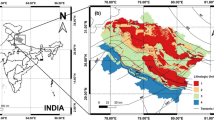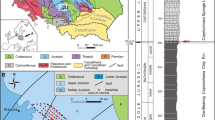Abstract
An integrated suite of environmental methods was used to characterize the hydrogeological, geological and tectonic regime of the largest waste disposal landfill of Crete Island, the Fodele municipal solid waste site (MSW), to determine the geometry of the landfill (depth and spatial extent of electrically conductive anomalies), to define the anisotropy caused by bedrock fabric fractures and to locate potential zones of electrically conductive contamination. A combination of geophysical methods and chemical analysis was implemented for the characterization and management of the landfill. Five different types of geophysical surveys were performed: (1) 2D electrical resistance tomography (ERT), (2) electromagnetic measurements using very low frequencies (VLF), (3) electromagnetic conductivity (EM31), (4) seismic refraction measurements (SR), and (5) ambient noise measurements (HVSR). The above geophysical methods were used with the aim of studying the subsurface properties of the landfill and to define the exact geometrical characteristics of the site under investigation.










Similar content being viewed by others
References
Acworth RI (1999) Investigation of dryland salinity using the electrical image method. Aust J Soil Res 37(4):623–636
Anagnostopoulos A, Koukis G, Sabatakakis N, Tsiambaos G (2003) Empirical correlations of soil parameters based on cone penetration tests (CPT) for Greek soils. Geotech Geol Eng 21:377–387
Atekwana EA, Sauck WA, Werkema Jr DD (2000) Investigations of geoelectrical signatures at a hydrocarbon contaminated site. J Appl Geophys 44:167–180
Augello AJ, Bray JD, Abrahamson NA, Seed RB (1998) Dynamic properties of solid waste based on back-analysis of OII landfill. ASCE J Geotech Geoenviron Eng 124(3):211–222
Benson RR, Glaccum A, Noel MR (1988) Geophysical techniques for sensing buried wastes and waste migration. National water well association, Dublin, OH, 236 pp
Bernstone C, Dahlin T, Ohlsson T, Hogland W (2000) DC-resistivity mapping of internal landfill structures: two pre-excavation surveys. Environ Geol 39:3–4
Bhowmick S, Ghosh N, Wadhwa RS (1996) Seismic refraction modelling and the importance of SH-waves for landfill site investigations. Environ Eng Geosci 2(2):262–264
Carpenter PJ, Calkin SF, Kaufmann RS (1991) Assessing a fractured landfill cover using electrical resistivity and seismic refraction techniques. Geophysics 56(11):1896–1904
Delgado J, Lopez Casado C, Estevez A, Giner J, Guenca A, Molina S (2000a) Mapping soft soils in the Segura river valley (SE Spain): a case study of microtremors as an exploration tool. J Appl Geophys 45:19–32
Delgado J, Lopez Casado C, Giner J, Estevez A, Cuenca A, Molina S (2000b) Microtremors as a geophysical exploration tool:applications and limitations. Pure Appl Geophys 157:1445–1462
Delgado J, Alfaro P, Galindo-Zaldivar J, Jabaloy A, Lopez Garrido AC, Sanz De Galdeano C (2002) Structure of the Padul-Niguelas Basin (S Spain) from H/V ratios of ambient noise: application of the method to study peat and coarse sediments. Pure Appl Geophys 159:2733–2749
Fawcett JD (1989). Hydrogeologic assessment, design and remediation of a shallow groundwater contaminated zone. In: Proceedings of the 3rd national outdoor action conference on aquifer restoration, ground water monitoring and geophysical methods. National Water Well Association, Orlando, pp 591–605
Fraser DC (1969) Contouring of VLF-EM data: Geophysics 34:958–967
Griffiths D, Barker R (1993) Two-dimensional resistivity imaging and modelling in areas of complex geology. J Appl Geophys 29:211.226
Hall DW, Pasicznyk DL (1987) Application of seismic refraction and terrain conductivity methods at a ground water pollution site in North-Central New Jersey. In: The 1st national outdoor action conference on aquifer restoration, ground water monitoring and geophysical methods
Hutchinson PJ (1995) The geology of landfills. Environl Geosci 2(1):2–14
Hutchinson PJ, Barta LS (2000) Geophysical applications to solid waste analysis. In: Zandi I, Mersky RL, Shieh WK (eds) The 16th international conference on solid waste technology and management, Philadelphia, PA, USA, December 10–13, 2000, pp 2–68 to 2–78, ISSN 1091–8043
Kalteziotis N, Sabatakakis N, Vassiliou A (1992a) Evaluation of dynamic characteristics of Greek soil formations. In: The 2nd Greek national conference on geotechnical engineering, Thessaloniki, October 21–23, vol 2, pp 239–246
Kalteziotis N, M. Pachakis C, Zervogiannis G, Tsiambaos, Sabatakakis N (1992b) Prediction of soil dynamic parameters from in situ tests. In: The 2nd Greek national conference on geotechnical engineering, Thessaloniki, October 21–23, vol 1, pp 189–196
Karlık G, Kaya A (2001) Investigation of groundwater contamination using electric and electromagnetic methods at an open waste-disposal site: a case study from Isparta, Turkey Environ Geol 40(6):34–42
Karous M, Hjelt SE (1983) Linear filtering of VLF dip angle measurements. Geophys Prospect 31:782–794
Kavazanjian E Jr, Matasovic N (1995) Seismic analysis of solid waste landfills. In: The geoenvironment 2000 speciality conference, ASCE, 2:1066–1080, New Orleans, Louisiana, 24–26 February, 1995
Kavazanjian E Jr, Matasovic N, Stokoe K, Bray JD (1996) In situ shear wave velocity of solid waste from surface wave measurements. In: The 2nd international congress environmental geotechnics, Osaka, Japan. Balkema, vol 1, pp 97–104
Konno K, Ohmachi T (1998) Ground-motion characteristics estimated from spectral ratio between horizontal and vertical components of microtremor, Bull Seismol Soc Am 88(1):228–241
Lanz E, Jemmi L, Muller R, Green A, Pugin A, Huggenberger P (1994) Integrated studies of Swiss waste disposal sites: results from georadar and other geophysical surveys. In: The 5th international conference on ground penetrating radar (GPR ‘94). Kitchener, Ontario, pp 1261–1274
Liao SSC, Whitman RV (1986) Overburden correction factors for spt in sand. J Geotech Eng, A.S.C.E., 112(3):373–377
Loke MH, Barker RD (1995) Least-squares deconvolution of apparent resistivity pseudosections, Geophysics 60:1682–1690
Loke MH, Barker RD (1996a) Rapid least-squares inversion of apparent resistivity pseudosections by a quasi-Newton method. Geophys Prospect 44:131–152
Loke MH, Barker RD (1996b) Practical techniques for 3D resistivity surveys and data inversion. Geophys Prospect 44:499–523
Loke MH (1997) Rapid 2D resistivity inversion using the least-squares method, RES2DINV Program manual, Penang, Malaysia
Loke MH (1999) Electrical imaging surveys for environmental and engineering studies: a practical guide to 2D and 3D surveys. 5, Cangkat Minden Lorong 6, Minden Heights, 11700 Penang, Malaysia (mhoke@pc.jaring.my). Downloaded from http://www.abem.se
Lontzetidis K, Raptakis D, Pitilakis K (1997) Correlation between V s -N(SPT) in Greek soils. In: The 3rd P.S.G.M, Patra, I, pp 419–425 (in Greek)
Mack TJ, Maus PE (1986) Detection of contaminant plumes in ground water of Long Island, New York, by electromagnetic terrain-conductivity surveys. USGS. Water resources investigations. 86–4045. 39 pp
Matasovic N, Kavazanjian E Jr (1998) Cyclic Characterization of OII Landfill Solid Waste. ASCE J Geotech Geoenviron Eng 124(3):197–210
McNeill JD (1980) Electromagnetic terrain conductivity measurement at low induction numbers. Geonics, Technical Note TN-6
McNeill JD (1990) Use of electromagnetic methods for groundwater studies. In: Ward SN (ed) Geotechnical and environmental geophysics: I. Review and tutorial. Society of exploration geophysicists, Tulsa, OK, pp 191–218
McQuown MS, Becker SR, Miller PT (1991) Subsurface characterization of a landfill using integrated geophysical techniques. In: The 5th national outdoor action conference on aquifer restoration, ground water monitoring and geophysical methods, May 13–16, 1991. Water Well Journal Publishing Co., Las Vegas, NV, pp. 933–946
Medlin E, Knuth M (1986) Monitoring the effects of a ground water recovery system with EM. In: Graves BJ, Lehr JH, Butcher K, Owen TE, Mathews M (eds) The surface and borehole geophysical methods and ground water instrumentation conference and exposition. National Water Well Association, Denver, CO, pp 368–378
Olhoeft GR (1986) Direct detection of hydrocarbon and organic chemicals with ground penetrating radar and complex resistivity. In: The NWWA/API conference on petroleum hydrocarbons and organic chemicals in ground water—prevention, detection and restoration. National Water Well Association, Dublin OH, Houston, TX, pp. 284–305
Olhoeft GR, King TVV (1991) Mapping subsurface organic compounds noninvasively by their reactions with clays. In: The 4th toxic substances technical meeting. Monterey, CA, pp 1–18
Orlando L, Marchesi E (2001) Georadar as a tool to identify and characterise solid waste dump deposits. J Appl Geophys 48:163–174
Parolai S, Borman P, Milkreit C (2001) Assessment of the natural frequency of the sedimentary cover in the cologne area (Germany) using noise measurements. J Earthq Eng 5(4):541–564
Parolai S, Bormann P, Milkereit C (2002) New Relationships between Vs, Thickness of Sediments and Resonance Frequency Calculated by H/V Ratio of Seismic Noise for Cologne Area (Germany). Bull Seismol Soc Am 92(6):2521–2527
Porsani JL, Filhob WM, Vagner RE, Shimelesa F, Douradob JC, Moura HP (2004) The use of GPR and VES in delineating a contamination plume in a landfill site: a case study in SE Brazil. J Appl Geophys 55:199–209
Powers CJ, Wilson J, Haeni FP, Johnson CD (1999) Surface-geophysical investigation of the University Of Connecticut Landfill, Storrs, Connecticut, Water-Resources Investigations Report 99-4211, U.S. Department of the Interior U.S. Geological Survey with the University of Connecticut
Rimrock Geophysics (1995) SIP SHELL: A software for interpretation of refraction seismics, Rimrock Geophysics Inc., USA
Rumbaugh JO III, Caldwell JA, Shaw ST (1987) A geophysical ground water monitoring program for a sanitary landfill: Implementation and preliminary analysis. In: Graves BJ, Lehr H, Butcher K, Alcorn P, Ammerman L, Williams P, Renz M, Shelton V (eds) The 1st national outdoor action conference on aquifer restoration, ground water monitoring and geophysical methods. National Water Well Association, Las Vegas, Nevada, pp. 623–641
Russell GM (1990) Application of geophysical techniques for assessing groundwater contamination near a landfill at Stuart, Florida. In: The FOCUS conference on eastern regional ground water issues. NWWA, Springfield, Mass. 2–77, pp 211–225
Sasaki Y (1989) 2-D joint inversion of magnetotelluric and dipole–dipole resistivity data. Geophysics 54:254–262
Sasaki Y (1992) Resolution of resistivity tomography inferred from numerical simulation. Geophys Prospect 40:453–464
Sauck WA (2000) A model for the resistivity structure of LNAPL plumes and their environs in sandy sediments. J ApplGeophys 44:151–165
Saunders WR, Cox SA (1987) Use of an electromagnetic induction technique in subsurface hydrocarbon investigations. In: Graves B, Lehr JH, Butcher K, Alcorn P, Ammerman L, Williams P, Renz M Shelton V (eds) The 1st national outdoor action conference on aquifer restoration, ground water monitoring and geophysical methods. National Water Well Association, Las Vegas, Nevada, pp 585–601
Scaife JE (1990) Using geophysical techniques in environmental site assessments. Municipal Ind Water Pollut Control 128(4):4–5
Seht, Malte Ibs-von, Jurgen Wohlenberg (1999) Microtremor measurements used to map thickness of soft sediments. Bull Seismol Soc Am 89(1):250–259
Skempton AW (1986) Standard penetration test procedures and the effects in sands of overburden pressure, relative density, particle size, aging and over consolidation. Geotechnique 36(3):425–447
Stanton GP, Schrader TP (2001) Surface geophysical investigation of a chemical waste landfill in northwestern arkansas, U.S. Geological Survey, 401 Hardin Road, Little Rock, AR 72211. In: Kuniansky EL (ed) 2001, US Geological Survey Karst Interest Group Proceedings, Water-Resources Investigations Report 01-4011, pp 107–115
Stenson RW (1988) Electromagnetic data acquisition techniques for landfill investigations. In: The symposium on the application of geophysics to engineering problems. The Society of Engineering and Mineral Exploration Geophysics, Golden, CO, pp 735–746
Tsourlos P (1995) Modelling interpretation and inversion of multi-electrode resistivity survey data: D.Phil. Thesis, University of York
Ulrych TJ, Lima OAL, Sampaio EES (1994) In search of plumes: a GPR odyssey in Brazil. In: The 64th annual international met. society exploration geophysical SEG, Los Angeles, USA, 569–572
Walther EG, Pitchford AM, Olhoeft GR (1986) A strategy for detecting subsurface organic contaminants. In: The petroleum hydrocarbons and organic chemicals in ground water, prevention, detection and restoration. National Water Well Association, Houston, TX, pp 357–381
Zekkos DP (2005) Evaluation of static and dynamic properties of municipal solid-waste, PhD Thesis, department of civil and environmental engineering, University of California at Berkeley. Also available at http://www.geoengineer.org
Acknowledgments
The project is co-funded by the European Social Fund and National Resources in the framework of the project Archimedes: “Support of Research Teams of Technological Educational Institute of Crete”, sub-project 2.6.6–MIS86455 entitled “Application of innovative techniques in landfills”. We would also like to thank the Institute of Engineering Seismology and Earthquake Seismology-ITSAK (N. Theodoulidis and A. Savvaidis) for providing the CityShark Microtremor system.
Author information
Authors and Affiliations
Corresponding author
Rights and permissions
About this article
Cite this article
Soupios, P., Papadopoulos, N., Papadopoulos, I. et al. Application of integrated methods in mapping waste disposal areas. Environ Geol 53, 661–675 (2007). https://doi.org/10.1007/s00254-007-0681-2
Received:
Accepted:
Published:
Issue Date:
DOI: https://doi.org/10.1007/s00254-007-0681-2




